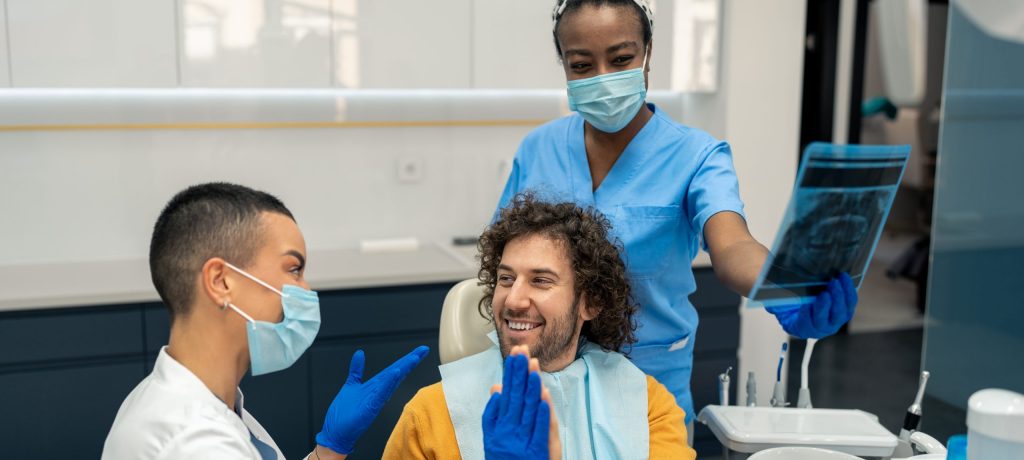Information Library
Start Reading

Even if your doctor has given you a clean bill of health, you may have a disease.
It’s largely preventable. In its early stages, it is easily treated. Yet 19% of the world’s population—more than 1 billion people—have severe cases. In the United States, nearly 50% of adults have some form of it. Many don’t even know it.
It’s periodontal disease. Sometimes, only a periodontist can treat it.
At Penn Dental Medicine (PDM), we find many patients don’t know the definition of a periodontist, or of periodontal disease. Yet this disease is one of the two biggest threats to dental health. (The other is tooth decay.)
Keep reading for more information about periodontal disease and how periodontists can help you keep your mouth in good health.
Periodontal disease is the result of an infection of the tissue around the teeth.
 “Gum disease” is a common synonym for periodontal disease. But in more serious cases, the infection can also affect the surface of the tooth root (the two-thirds of the tooth below the gum line, extending into the bone), the periodontal ligament (the connective soft tissue anchoring the root to the bone’s teeth sockets), and the jawbones.
“Gum disease” is a common synonym for periodontal disease. But in more serious cases, the infection can also affect the surface of the tooth root (the two-thirds of the tooth below the gum line, extending into the bone), the periodontal ligament (the connective soft tissue anchoring the root to the bone’s teeth sockets), and the jawbones.
Bacteria in the mouth cause periodontal disease. Initially, the bacteria form plaque, a sticky film that irritates and inflames the gums. This condition, called gingivitis, is the mildest, most treatable stage of periodontal disease.
If not removed, plaque hardens into tartar (calculus). As tartar builds up, it allows even more plaque to form. When plaque and tartar settle below the gumline, advanced periodontal disease, or periodontitis, results. It can lead to infection, bone loss, and loose and lost teeth.
Research reveals links between periodontal disease and increased risk of systemic, potentially life-threatening diseases, including heart disease, respiratory disease, cancer, and diabetes.
Symptoms of periodontal disease include:
 You can find clues to the “periodontist” definition in the word’s origins. It combines the Greek words “peri” (“around”) and “odont” (“tooth”).
You can find clues to the “periodontist” definition in the word’s origins. It combines the Greek words “peri” (“around”) and “odont” (“tooth”).
What is periodontics, then? It’s the dental discipline devoted to everything “around the tooth”—tooth roots, the gums, and the jawbones. And a periodontist is a dentist who works “around the tooth.”
The American Academy of Periodontology (AAP) offers this fuller periodontist definition: “a dentist who specializes in the prevention, diagnosis, and treatment of periodontal disease, and in the placement of dental implants.” Periodontists also treat any form of oral inflammation.
Periodontists receive three years of education and training beyond what dental school requires of students training to be general dentists. Periodontists’ extra schooling ensures they are well-prepared to address problems involving your teeth’s surrounding tissue and supporting structures.
If detected early, periodontal disease is treatable and reversible. Properly brushing, flossing, and using antibacterial rinses will help. Sticking to a regular schedule of dental visits helps, too.
Unfortunately, patients often wait too long to seek help. By the time they finally do, their teeth may have undergone extensive damage. They may then need surgical procedures and reconstructive work.
Periodontal services include:
This “deep cleaning” below the gumline involves removing plaque and tartar from the tooth’s surface and smoothing the root’s surface to help gums reattach to the tooth.
This is another form of deep cleaning, controlling bacterial infection in the pockets (spaces created when gums pull away from the teeth) and the tissue beneath.
Topical or oral antibiotics can help control periodontal disease. Your periodontist may have you use an antibiotic mouth rinse or put an antibiotic gel into your gum pockets.
Pocket reduction surgery, gum grafts, and bone grafts are some surgical options for treating advanced periodontal disease.
Although prosthodontics is a separate specialty from periodontics, both deal with dental implants. According to the AAP, periodontists, as “experts on both soft and hard tissues,” have “the ideal combination of experience and knowledge to make sure you get a dental implant solution that looks and feels like your own teeth.”
You can now define periodontics. You know the definition of “periodontist.” Next, it’s time to find quality, affordable periodontal treatments in Philadelphia.
At PDM, our student periodontists use advanced materials, the latest evidence-based techniques, and patient-focused approaches. They train under the guidance of some of the nation’s and world’s top dental professionals, some of whom are also dental school faculty.
And PDM’s educational purpose means you pay less—50% to 70% less, on average—than you would at a private practice.
Get and keep your gums and jaws in good health. Schedule your appointment online now or call us at 215-898-8965.